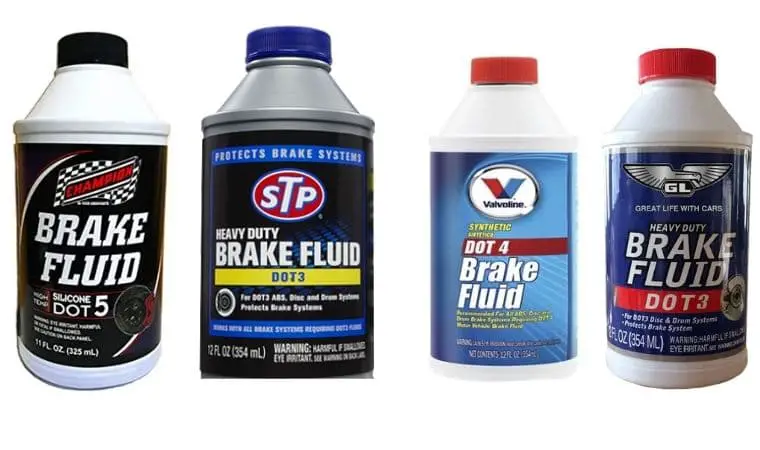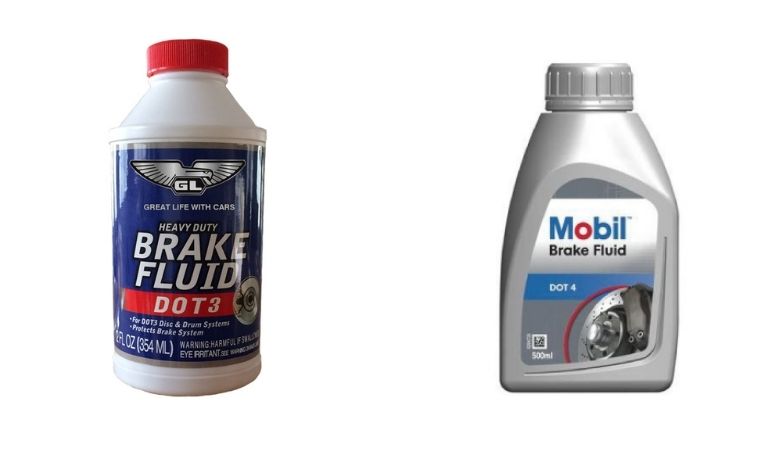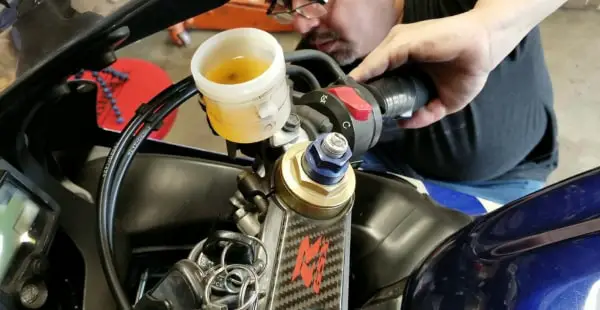You’re driving down the road while a pedestrian tries to cross the street out of nowhere. You need to stop the car immediately, so you push down the brake pedals. Marvelous save!
But, do you know how many mechanisms are there in this whole process, from pressing down the pedals to stop the car? Let me tell you, PLENTY! And all these components work efficiently with brake fluid.
But, as a vehicle owner, you may often wonder, “what kind of brake fluid do I need?” I’ll come to that!
All modern-day vehicles are equipped with hydraulic brakes. There’s a hydraulic fluid residing inside the brake services. It uses the pressure of pedal to put a halt to the vehicle.
These fluids are known as brake fluids that help the hydraulic components to work. Today, I’m going to walk you through the types of brake fluids that you can use in your vehicle.
What are the Different Types of Brake Fluid?

I’d not be surprised if you aren’t familiar with any type of brake fluid. After all, this isn’t something you’d spend much time thinking about.
Now, to keep your brake lines and brake pads efficient enough to prevent brake failure, you’ve to choose the correct type of clean fluid.
Glycol-Based Fluids
Most of the vehicles use glycol-based fluids as a rule of thumb. There are DOT 3, 4, and 5.1.
- DOT 3
DOT brake fluid is a fluid type of glycol-based brake fluid. This fresh fluid has 3 other types so far for brake hardware. It was the most popular type of fluid used for brake maintenance till DOT 4 was invented.
Fresh or new, 401 degrees ℉ is the boiling point of DOT 3 fluid. When damaged, it decreases to 284 degrees. However, as the fluid is corrosive, you have to wipe it off with water and soap.
Also, this fluid soaks moisture content from the air. This is why, you shouldn’t keep the brake fluid reservoir open. Excess moisture will make the brake pads spongy, and the brake lines will eventually fail to work.
- DOT 4
An improved version of the DOT 3 is the DOT 4. It helps the brake hydraulic to work much more efficiently. It comes with a higher boiling point than the DOT 3, 446 degrees Fahrenheit.
Along with that, this fluid has less water contamination than the DOT 3. Regarding that, most of the European car manufacturers are using the DOT 4.
Another essential aspect of the DOT 4 is that it comes in higher boiling points than its base version. The specialized versions are called Super DOT 4 and are used for high-quality cars.
- DOT 5.1
A further improved version of DOT 4 is the DOT 5.1 that’s even better for your brake lines and a brake pedal. It’s much more resistant to heat and comes with a 500 degree Fahrenheit boiling point.
With the proper fluid level of DOT 5.1, your brake caliper will hardly show any trouble working.
But, the downside of DOT 5.1 is that it’s costly. Some of the specialized DOT 4 brake fluids have better specifications than the DOT 5.1, and they’re cheaper.
Silicone-based Brake Fluid
Enough about glycol! Specifications for brake fluid don’t say that you can’t use anything else other than glycol-based brake fluids. Instead, I’ve found silicone brake fluids to work even better in some cases.
- DOT 5
When you saw the DOT 5.1 in glycol fluid, you surely were wondering about the presence of DOT 5. Well, here it is!
DOT 5 is a silicone-based fluid that has a higher boiling point than average DOT 4 or 5.1. The base boiling point of it is 500 degrees Fahrenheit, enough for the braking system to endure heavy loads.
Another great thing about DOT 5 is that it doesn’t absorb water like DOT 3 and eventually stops internal corrosion. The fluid performance is sometimes even better than Glycol-based DOT fluids.
But, one of the downsides of DOT 5 is that it gets foamy and generates air bubbles. The bubbles make it hard to bleed the brakes naturally without brake fluid flush. That’s why, DOT isn’t entirely suggested for the ABS systems.
Although DOT 5 is more refined than the DOT 3 or 4, you can’t mix it with them. It is costly and helps the anti-lock braking system making a good turn.
What Kind of Brake Fluid Do I Need?

The type of fluid you need will depend on several factors. First of all, you have to go through the vehicle’s service manual and find out as much information you can find.
If the manufacturers have recommended using a certain kind of fluid, that’s what you should use. If it’s not specified, you have to know all about your braking system.
You can apply DOT 3 brake fluid to the clutch if your vehicle has drum brakes or disc brakes, These types of brakes don’t require much boiling point, so it’ll be enough for them.
When it comes to hydraulic braking systems, your options are vast. It starts with DOT 4 that comes at 446 degrees Fahrenheit. While it’s pretty adequate, you can always get the better one. DOT 5.1 has a boiling point that’s even higher than DOT 4.
But, they come with a price. DOT 3 is the cheapest, and DOT 5.1 is the most expensive brake fluid among the glycol-based brake fluids.
If you want to try out the silicone-based brake fluid, then your option is DOT 5, which is basically superior to DOT 3 or 4, but more expensive.
Now, it’s up to you to decide which factor is prominent to you and choose the kind of brake fluid accordingly.
What are the Most Common Brake Fluid Problems?

One of the most common brake fluid problems is the low boiling rate. If you don’t buy a good-quality brake fluid, it’s likely to have lower boiling points than average brake fluids.
- Leaks in Brake Fluid
Give a routine check to the brake fluids. If it’s leaking, the hydraulic pressure will decrease and air will hop into the system. It eventually leads to brake corrosion and decreased brake performance.
To solve this issue, you’ve to check the master cylinder, brake fluid reservoir cap, and brake line. Try to examine if any of these are broken. If you find any, this is what you have to fix right away.
- Moisture Intrusion Issues
Fluid moisture intrusion issues lead to spongy brake pads, which cause brake failure. Experts often warn about absorbent brake pads. These could cause serious accidents!
Brake system components include brake caliper, disc brake/drum brake/hydraulic brake, and master cylinder—all of these function through a piston that needs to be sealed.
If you find the piston to be damaged, replace it as soon as you can. The characteristics of brake fluid won’t come in much handy if you have a broken piston.
The best way to fix brake fluid issues is to visit an acclaimed auto repair expert. If you want to do it yourself, make sure that you’re not letting external moisture access the braking system.
Frequently Asked Questions (FAQ)
Are DOT 3 and DOT 4 brake fluids interchangeable?
Yes, DOT 3 and DOT 4 brake fluids are compatible or interchangeable, and you can mix the two types of fluid. But, I’d suggest not doing it.
DOT 4 has a higher wet boiling point than DOT 3. Also, it’s much more expensive than DOT 3. Eventually, the actual application of brake fluids will not be adequate as the boiling points will not be what you expect.
Does brake fluid go bad or need to be changed?
Yes, definitely! Brake fluids absorb moisture from the air. As they keep doing so, they lose the effectiveness over time of increasing the driving conditions for a heavy, fast-moving vehicle.
The brake pressure will not stop the vehicle as it should if the brake fluid has gone bad. So, changing the contaminated brake fluid is one of the essential elements of vehicle safety.
How often should you change your vehicle’s brake fluid?
Fluid change intervals are not something that you’d set as a rule. It depends on a lot of factor like fluid manufacturers, demanding conditions of the braking system, ambient conditions of the surrounding environment, aggressive braking, possible contact with water, etc.
Also, extreme heat can make the brake fluid go bad quicker than usual. The effects of heat on brake fluid are immense. This is where heat sinking can be proven helpful.
Every time you take your vehicle to check your engine oil, get the mechanic to have a look at the brake fluid as well. Above all, I’d suggest changing your brake fluid every 2-3 years.
How much does brake fluid cost?
The exact brake fluid price depends on the DOT brake fluid types. As I’ve already discussed earlier, different types of fluids have different efficiency. So, the prices vary based on their type as well.
However, on average, brake fluids can cost between $80-$150.
What color is normal brake fluid?
Clean and normal brake fluid should seem clear with a bit of yellowish hint. If it looks black or brown, you’re up for a flushing. And in this process, brake fluid flushing involves brake fluid renewal as well.
What kind of brake fluid do I need for a motorcycle?
For motorcycles, DOT 5.1 or 4 would be the perfect choice for you. Both of them have similar characteristics of absorbing much moisture. DOT 5.1 is more expensive than DOT 4, so your budget is the only thing you have to consider.
What kind of brake fluid do I need for my Harley?
Most of the motorcycles need DOT 4 or 5.1 brake fluid, which are both glycol-based. But, it’s different for Harley.
According to the manufacturers, to ensure maximum braking performance, you have to use silicone-based brake fluid. And DOT 5 is the preferable option for brake fluid to use for Harley.
Read more harley product
- The Best Full Face Helmet For Harley Riders
- Best Fuel Management System For Harley Davidson
- Best Spark Plugs For Harley Davidson
Conclusion
Using a good brake fluid is not enough to prevent brake system component corrosion. You also have to take care of brake fluid as well. If there’s excess water in your fluid from moisture absorption, the fluid will be harmful.
However, working with the brakes of cars with ABS brakes might seem harder. If you’re confused, watch some brake kit installation videos, or just take the vehicle to a store of brake inspection nearest to you.
Now, I believe I’ve answered your question, “what kind of brake fluid do I need”! If you’re still feeling lost, just read the manufacturer’s manual or service manual to find out more about your vehicle or see a professional.
